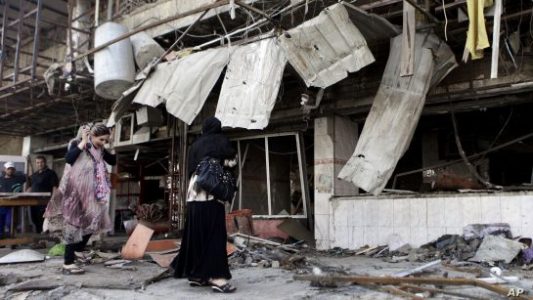
Islamic State remains unpredictable as it regroups
The Islamic State terror group is adapting to the loss of its self-declared territorial caliphate by returning to its origins and becoming once again a more local, Iraq-focused insurgency, and is recruiting in remote border areas in Iraq’s western desert. But it still harbors ambitions to strike in the West, warn European officials and analysts.
Britain’s Security Minister Ben Wallace on Thursday warned that Islamic State and rival jihadists in al-Qaida remain a serious threat to the West. Exploiting the internet and social media platforms, IS can still recruit Westerners, and if not organize attacks itself at least inspire adherents to strike, he said.
“That means that everyone has potentially an ISIS problem in every country around the world,” he told Britain’s Sky News. “It is a different type of threat because at the moment it’s manifesting itself in lone actors.”
For security services the threat is unpredictable “because they have to watch one person who may be just literally talking to themselves on one day and the next day they’ll go and grab a knife or a truck.”
But IS has not lost the ambition to plot and organize terror attacks in the West itself.
In the current top IS leadership, two out of 12 members of al-Lajna al-Mufawada, the group’s Cabinet, are tasked with overseeing operations abroad. They are Sukru Tuncer, a Frenchman of Turkish origins, and Abu ‘Ammar al-Sa’udi, a Saudi. But analysts say Daesh, the group’s Arab acronym, has had to return to its roots as a mainly Iraq-based insurgency force and is undergoing a generational change. Nonetheless it has the capacity to reemerge, if it’s ignored.
“It still survives as result of the temporary lack of interest that various belligerents in the Syrian war show in the region in which Daesh remains,” say analysts Ronen Zeidel and Hisham al-Hashimi in a study of the group published in the latest edition of Perspectives on Terrorism, a peer-reviewed journal. “This lack of attention works in favor of the organization and is willing it to regroup,” they argue.
“In Iraq they maintain a clandestine presence in the Hamrin and Makhul hilly region between the provinces of Salah al-Din, Diyala and Kirkuk, in Sharqat and Qiyara south of Mosul and in the western desert. This presence is confined to uninhabited areas, but poses a daily threat to the population in the Sunni periphery,” they say. Among the prime goals of the leadership is to sow and reactivate “sleeper cells” in Iraq for attacks in bigger cities and to transfer fighters across border with Syria into Iraq in order to increase its presence there, they say.
In Syria, IS is training and recruiting in the desert areas south-west of the Euphrates, an area supposedly under control of the Syrian government of Bashir al-Assad, but neglected now as the Syrian army focuses on the last remaining enclave of anti-Assad rebels and al-Qaida-tied groups in north-west Syria. But the modes of IS operation differ between Iraq and Syria, where the threat of air strikes forces the group to be be defensive.
In Iraq the group’s commanders have more freedom to plan operations and attacks have increased in tempo steadily over the last year with government officials and local ‘collaborators’ targeted in the Sunni countryside. Executions in villages Mukhtars (local dignitaries) are filmed as a lesson to others.
“Defeat brought the organization back to its basic essence: a small, marginal Sunni-Iraqi terror/guerrilla force, capable of waging small wars, intimidating populations and carrying out terror attacks in peripheral areas, exploiting the geopolitical and governmental vacuum there. In fact, Daesh became a more practical, matter-of-fact organization. Its organizational changes are impressive. Apparently, this is the heritage of men who served in Saddam Hussein’s highly organized security services,” write authors Zeidel and al-Hashimi.
Source: VOA





